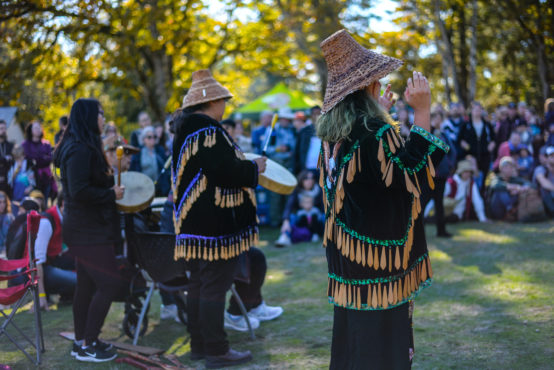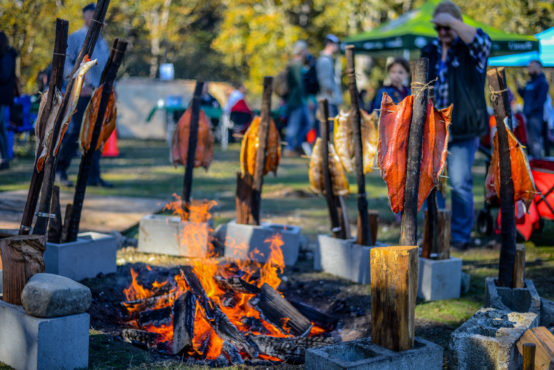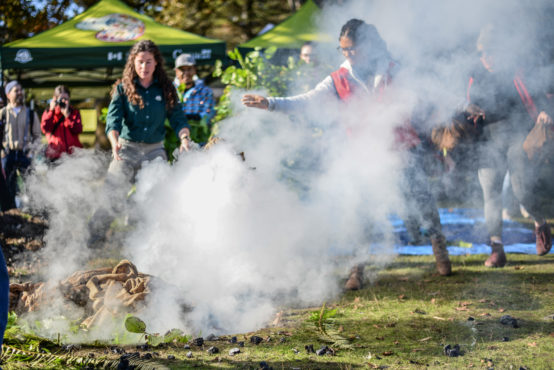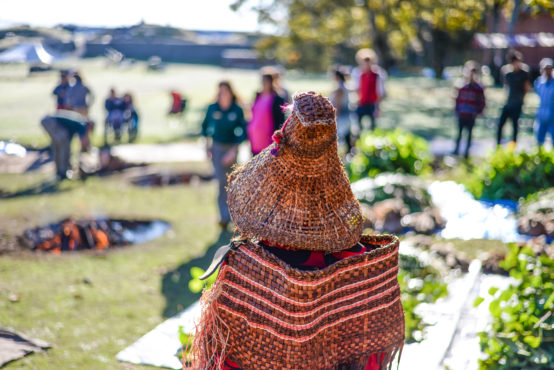Members of Songhees Nation, with support from Parks Canada, hold first traditional pit cook at Fort Rodd Hill since the site’s designation as a fort for European settlers

All photos by Mike Graeme, Senior Staff Writer.
Saturday, Oct. 13 was a historical day for Songhees and Esquimalt First Nations, Parks Canada, and Vancouver Islanders, as these communities came together to celebrate a traditional Coast Salish pit cook at Fort Rodd Hill National Historic Site.
The full-day traditional Coast Salish cooking event hasn’t happened at this location since it became an artillery base for European settlers in the late 1890s.
Cheryl Bryce, a member of the Songhees Nation and head director of the pit cook, says the tradition has been ongoing elsewhere on southern Vancouver Island, but that doing it at Fort Rodd Hill for the first time since it became a fort is a big step forward.
“I’ve been doing this for so long, and been doing it in so many different locations, both in our community on the reserve lands as well as our ancestral lands, and today is the first day that we’ve done it post-contact here at Fort Rodd Hill,” she said.
Sara Lax, a Parks Canada Communications and Outreach Assistant and University of Victoria student, agreed that the event was a milestone.

“It’s very historical in that it’s the first time [a Songhees-led pit cook has] ever been done on a Parks Canada site in history,” said Lax. “And having it at a National Historic Site is a very powerful message that is being communicated.”
Camas, chocolate lily, and other root vegetables slow-cooked underground for hours in layers of fern, salal leaves, and hot rocks, while people participated in workshops on cedar weaving, Indigenous foods and medicines, and place-based storytelling.
Before European arrival, Fort Rodd Hill served as a Lekwungen village site and camas field for generations, Bryce said.
“‘[There’s] lots of history here. You can imagine the longhouses that would have been along the foreshore.”
Bryce said working with the camas is like working with the legacy of her ancestors.
Now, that foreshore is more widely known among the general public as the site of Canada’s first lighthouse on the west coast.
But the importance of the area as a camas cultivation site should not be understated. Before colonizers showed up, “[other Nations] would come from up and down the coast … to trade for [Coast Salish] camas,” Bryce said.
“You know we call Victoria, ‘Victoria,’ but long before it was ever Victoria, it was ‘Place of Harvesting Camas,’” said Lax.
The camas that was feasted on by over 300 people at the event on Saturday had been tended to by members of Songhees and Esquimalt First Nations, Parks Canada staff, and volunteers for over five years.

The tone of the event was not a somber remembrance of a regretful past. Rather, the focus was about celebrating Coast Salish history and envisioning a resilient future.
“Today is about sharing the experience so that people get a better understanding of … the history of the Garry oak ecosystem, and what … it [means] when they’re walking [around Coast Salish territory] — the deeper rooted history,” Bryce said.
“Rooted” is certainly a suitable term to refer to both the cultural and ecological history of the area. The ancient Garry oaks framing the grassy lawn at Fort Rodd Hill are here because Bryce’s ancestors worked hard at cultivating roots, like camas.
By burning fields for camas to grow, the Coast Salish food system co-created the surrounding ecosystem.
“It’s a very important food system, and if it wasn’t properly [maintained] — if that role and responsibility wasn’t fulfilled — then [the Garry oaks] wouldn’t be here today,” said Bryce. “The [Douglas] firs would move in, the shrubs would move in. So all of the work was so important to continue and carry on through the year.”
“Places can have layers of culture and meaning to different people.”
“The way my ancestors took care of this food system was amazing.”
Bryce said working with the camas is like working with the legacy of her ancestors.
“To me they’re really living artifacts [of] my ancestors. They’re here because of the way the women sustained them and passed them down through the generations.”
As a Songhees woman, Bryce sees it as her responsibility to carry on those family values and cultural roles.
“Cheryl [Bryce] is such a strong knowledge holder and educator in this community and she is so willing to share with people whether you’re Indigenous or non-Indigenous,” said Lax. “I think it’s really igniting the spirit of this place.”
Just like the insides of a pit cook are layered with hot rocks, steaming plant blankets, and root bulbs, so too is there a strata of this landscape’s history embedded within the soil of Fort Rodd Hill.

“Places can have layers of culture and meaning to different people,” said Lax. “I think sometimes when visitors come to a National Historic Site, they come with an expectation, but this event is about realizing that there is more to a place than maybe what’s advertised.”
Bryce was excited that she could be a part of helping the public conceptually — and literally — digest this part of the Coast Salish world.
“I can’t stop moving. It’s just amazing. I’m just so happy to be able to see this day happen and to be able to share that experience with everyone,” said Bryce. “We’re letting the bulbs know we still need them, letting all the plants know we still need them.”
“This is a resurgence of Indigenous culture, and knowledge, and right, and strength on this land.”
Bryce added that watching the next generation of children participating in the event as being a highlight for her.
“It’s always good to see their hands in the dirt and connecting to this place.”
Before the pit ovens were opened at 2:30 p.m., everyone stood in a circle to watch the Lekwungen Dancers welcome the unveiling of the feast through movement and song. As the dance was happening, Lax looked around the space and realized the effect that the dance, and the pit cook as a whole, was having on people.
“People’s eyes were just locked in on what was going on and I think everybody’s curiosity and feeling — like spiritual feeling — of this place really came alive.”

Lax said this historical moment also marks a milestone in the relationship between Parks Canada and Songhees and Esquimalt Nations.
“I think it’s just really powerful … that this relationship is being built and this event — this Coast Salish pit cook — is a celebration of that budding relationship.”
Parks Canada has been working with Songhees and Esquimalt First Nations at the Fort Rodd Hill site since 2011.
“This is a resurgence of Indigenous culture, and knowledge, and right, and strength on this land.” said Lax.
“Having Indigenous leaders in these roles of power is exactly what we want and what we’re hoping will happen in the future.”
This article was amended on Oct. 26 at 11:30 a.m.








